Homeostasis and Response
1.1 Homeostasis
The regulation of internal conditions to maintain optimal conditions for enzyme action and cell function.
Purpose – to maintain the established internal environment without being overcome by external stimuli that exist to disrupt the balance.
In the human body, these include control of:
blood glucose concentration
body temperature
water levels.
These automatic control systems involve nervous responses and chemical responses.
All control systems include:
cells (receptors)
detect stimuli (changes in the environment)
coordination centres (brain, spinal cord and pancreas)
receive and process information from receptors
effectors, muscles or glands
bring about responses which restore optimum levels
1.2 The Human Nervous System
1.2.1 Structure and Function
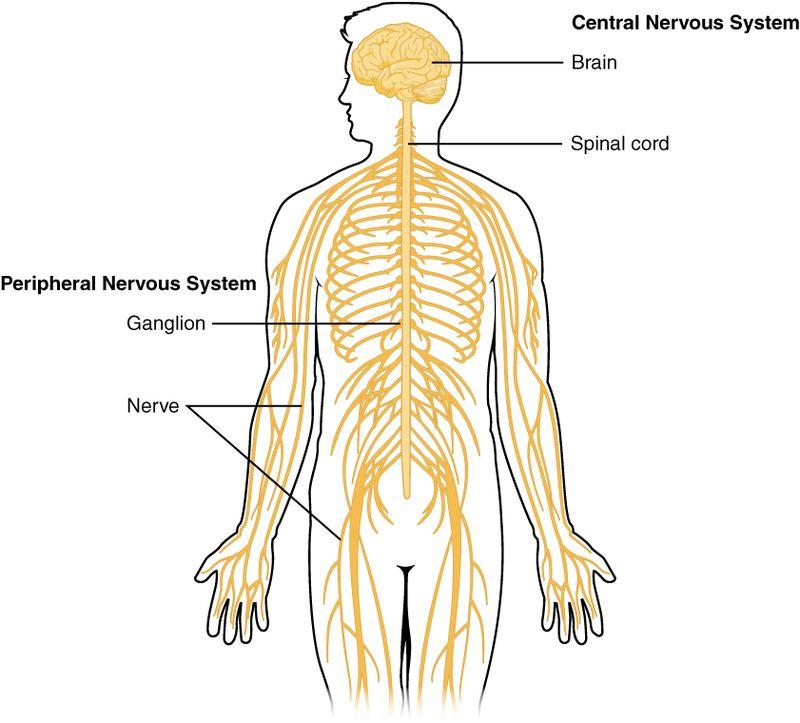 Nervous System: Enables humans to react to their surroundings and to coordinate their behaviour.
Nervous System: Enables humans to react to their surroundings and to coordinate their behaviour.
Information from receptors passes along cells (neurones) as electrical impulses to the central nervous system (CNS). The CNS then coordinates the response of effectors which may be muscles contracting or glands secreting hormones.
stimulus → receptor → coordinator → effector → response
The human nervous system consists of:
Central nervous system – the brain and spinal cord
Peripheral nervous system – nerve cells that carry information to or from the CNS
Ganglion – a cluster of nerve cells found in the peripheral nervous system.
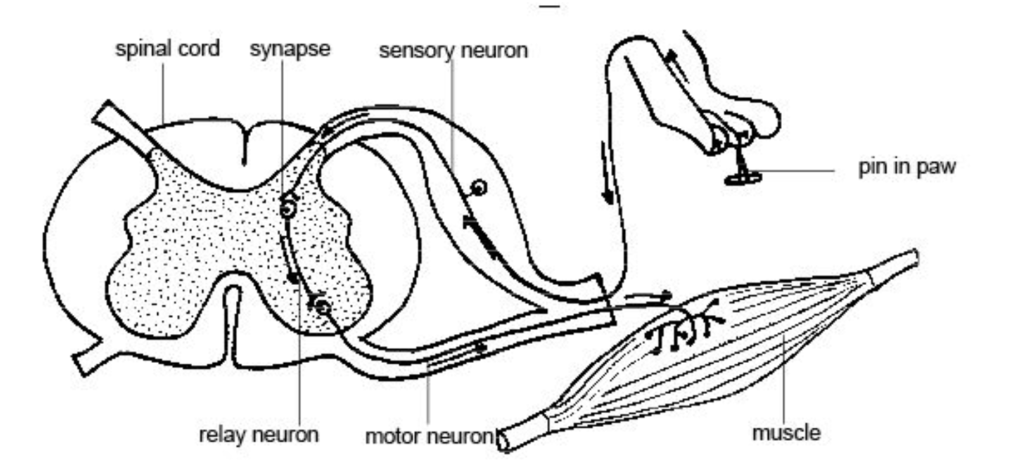 Reflex Arc: A neurological and sensory mechanism that controls a reflex, an immediate response to a particular stimulus.
Reflex Arc: A neurological and sensory mechanism that controls a reflex, an immediate response to a particular stimulus.
Reflex actions are automatic and rapid; they do not involve the conscious part of the brain.
It protects the body from things that can harm it.
This includes the following structure such as:
Sensory Neurone: The nerve cells activated by sensory input from the environment.
Synapse: Connect neurons and help transmit information from one neuron to the next.
Relay Neurone: Allows sensory and motor neurons to communicate. (found in the brain and spinal cord)
Motor Neurone: Controls muscle movements. (found in the CNS)
1.2.2 The Brain (biology only)
Brain: A complex organ that controls thought, memory, emotion, touch, motor skills, vision, breathing, temperature, hunger and every process that regulates our body.
It is made of billions of interconnected neurones and has different regions that carry out different functions.
The brain structure includes;
Cerebral Cortex: The outer layer of the brain’s surface that carries out essential functions such as memory, thinking, learning, reasoning, problem-solving, emotions, consciousness, and sensory functions.
Cerebellum: Responsible for coordinating movement and balance.
Medulla: Manages heart, circulation and breathing.
Hypothalamus: Helps manage your body temperature, hunger and thirst, mood, sex drive, blood pressure and sleep.
Pituitary gland: Monitors and regulates many bodily functions through the hormones that it produces.
1.2.3 The Eye (biology only)
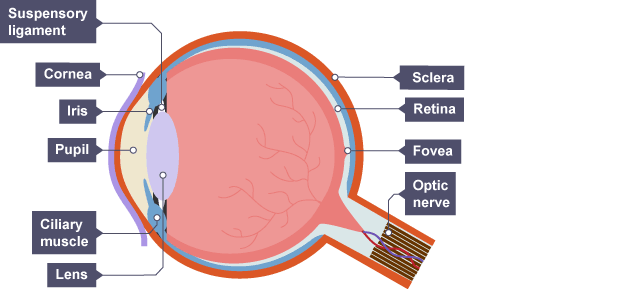 Eye: A sense organ containing receptors sensitive to light intensity and colour.
Eye: A sense organ containing receptors sensitive to light intensity and colour.
The structure of the eye includes;
Suspensory Ligament: A series of fibres that connect the ciliary body of the eye with the lens, holding it in place.
Cornea: Acts as the outermost lens and functions like a window that controls and focuses the entry of light into the eye.
Iris: The coloured tissue of the eye that control the size of the pupil to let more or less light into the eye.
Pupil: The opening in the centre of the iris that allows light to enter the eye so it can be focused on the retina to begin the process of sight.
Ciliary body and muscle: Ciliary body produces aqueous humor. It also contains the ciliary muscle, which changes the shape of the lens when your eyes focus on a near object.
Lens: Its function is to transmit and focus light onto the retina.
Sclera: The white outer coating of the eye that maintains your eye's shape and protects it from injuries.
Retina: It converts light that enters into your eye into electrical signals your optic nerve sends to your brain which creates the images you see.
Fovea: A small depression within the neurosensory retina where visual acuity is the highest.
Optic Nerve: It transmits electrical impulses from your eyes to your brain.
Accommodation: The process of changing the shape of the lens to focus on near or distant objects.
To focus on a near object;
The ciliary muscles contract,
The suspensory ligaments loosen,
The lens is then thicker and refracts light rays strongly.
To focus on a distant object;
The ciliary muscles relax,
The suspensory ligaments are pulled tight,
The lens is then pulled thin and only slightly refracts light rays.
Two Common Defects of the Eye
Myopia: short-sightedness
Hyperopia: long-sightedness
These defects are treated with spectacle lenses which refract the light rays so that they focus on the retina.
New technologies now include hard and soft contact lenses, laser surgery to change the shape of the cornea and a replacement lens in the eye.
1.2.4 Control of Body Temperature (biology only)
Body Temperature: A measure of how well your body can make and get rid of heat.
It is monitored and controlled by the thermoregulatory centre in the brain.
Thermoregulatory Centre: Contains receptors sensitive to the temperature of the blood.
The skin contains temperature receptors and sends nervous impulses to the thermoregulatory centre.
Too high body temperature makes blood vessels dilate (vasodilation) and sweat is produced from the sweat glands. Both these mechanisms cause a transfer of energy from the skin to the environment.
Too low body temperature makes blood vessels constrict (vasoconstriction), sweating stops and skeletal muscles contract (shiver).
1.3 Hormonal Coordination in Humans
1.3.1 Human Endocrine System
Hormones: Chemical messengers that enter the blood directly upon their secretion from endocrine glands.
Hormonal Coordination: involves the interaction between hormones and target cells or tissues, which regulate functions such as metabolism, growth, reproduction, and stress response.
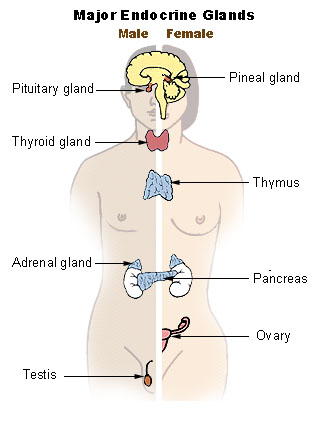 Endocrine System: Composed of glands which secrete chemicals called hormones directly into the bloodstream.
Endocrine System: Composed of glands which secrete chemicals called hormones directly into the bloodstream.
The blood carries the hormone to a target organ where it produces an effect.
Compared to the nervous system the effects are slower but act for longer.
The endocrine system consists of the following glans such as;
pituitary gland
pancreas
thyroid
adrenal gland
ovary (in women)
testes (in men)
The pituitary gland in the brain is a ‘master gland’ which secretes several hormones into the blood in response to body conditions.
These hormones in turn act on other glands to stimulate other hormones to be released to bring about effects.
1.3.2 Control of Blood Glucose Concentration
Blood Glucose Concentration: monitored and controlled by the pancreas which is measured from capillary blood obtained from a finger prick.
If the blood glucose concentration is too high, the pancreas produces the hormone insulin that causes glucose to move from the blood into the cells.
Insulin: A hormone that tells cells throughout your body to take in glucose from your bloodstream. As the glucose moves into your cells, your blood glucose levels go down.
In liver and muscle cells excess glucose is converted to glycogen for storage.
Diabetes: A chronic disease that occurs either when the pancreas does not produce enough insulin or when the body cannot effectively use the insulin it produces.
Type 1 Diabetes: A disorder in which the pancreas fails to produce sufficient insulin.
The pancreas does not make insulin, because the body's immune system attacks the islet cells in the pancreas that make insulin.
It is characterised by uncontrolled high blood glucose levels.
Normally treated with insulin injections.
Type 2 Diabetes: A disorder where the body cells no longer respond to insulin produced by the pancreas.
The pancreas makes less insulin than used to, and your body becomes resistant to insulin.
Obesity is a risk factor for Type 2 diabetes.
A carbohydrate-controlled diet and an exercise regime are common treatments.

1.3.3 Maintaining Water and Nitrogen Balance in the Body (biology only)
Osmosis Changes: (shock or stress) is a physiologic dysfunction caused by a sudden change in the solute concentration around a cell, which causes a rapid change in water movement across its cell membrane.
Osmotic changes in body fluids can have significant effects on cells that include;
Cell Swelling or Shrinking (Osmosis)
Cell Membrane Distortion
Ion Imbalance
Metabolic Effects
Cellular Function Disruption
Cellular Damage and Death
If body cells lose or gain too much water by osmosis they do not function efficiently.
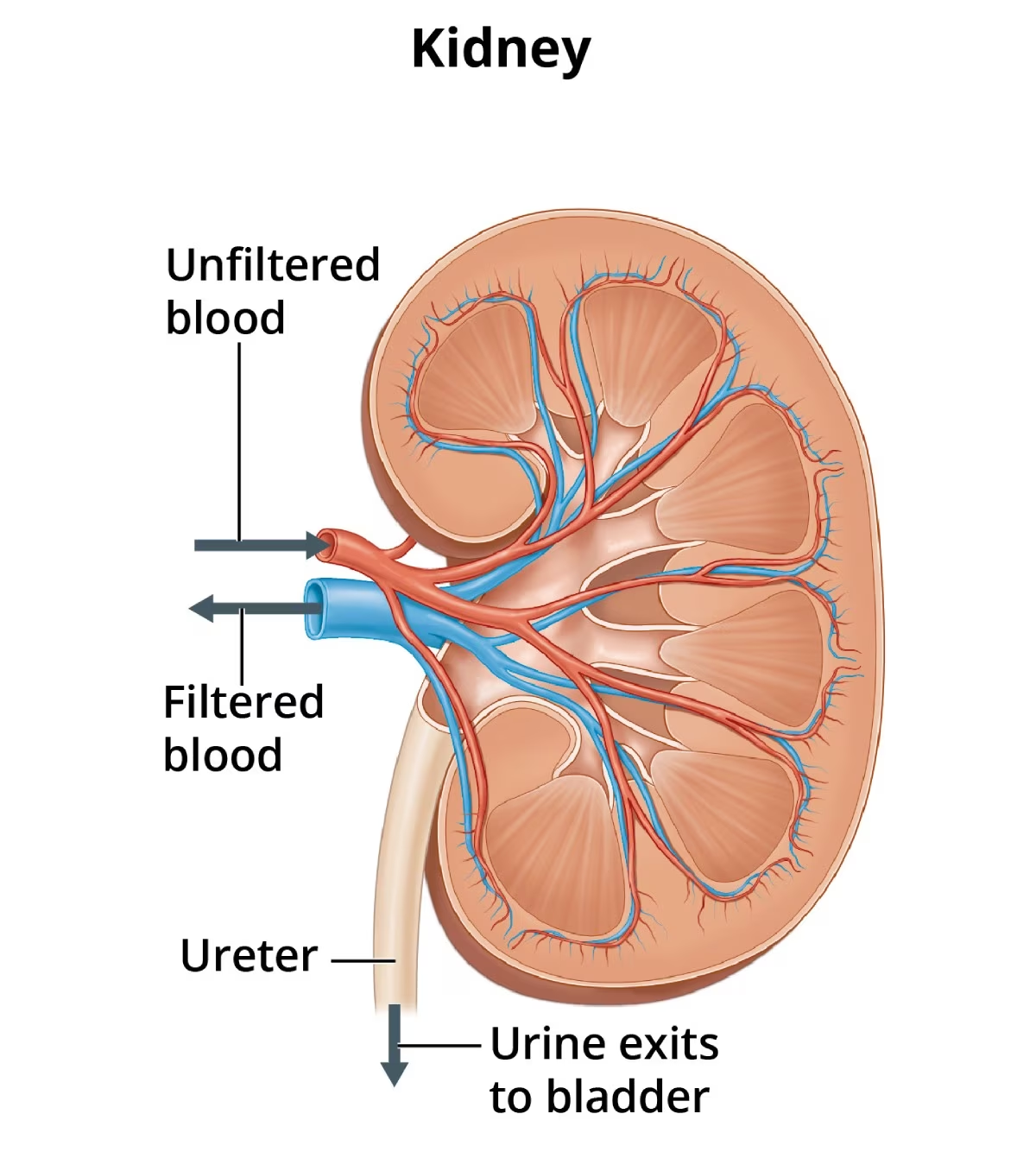
Kidney: One of a pair of organs in the abdomen that removes waste and extra water from the blood (as urine) and helps keep chemicals (such as sodium, potassium, and calcium) balanced in the body.
It can directly control the volume of bodily fluids by the amount of water excreted in the urine. They can;
Conserve water by producing urine that is concentrated relative to plasma, or
Get rid of excess body water by producing urine that is dilute relative to plasma.
Tables and Bar Charts
The concentration of the substances in the fluids is measured in grams per dm3:
Substance | Blood plasma | Filtrate in the kidney tubules | Urine |
|---|---|---|---|
Water | 850.0 | 850.0 | 900.0 |
Protein | 75.0 | 0.0 | 0.0 |
Glucose | 0.9 | 0.9 | 0.0 |
Amino acids | 0.4 | 0.4 | 0.0 |
Urea | 0.3 | 0.3 | 22.0 |
Sodium ions | 2.7 | 2.7 | 3.6 |
Kidney Failure: One or both of your kidneys no longer function well on their own.
People who suffer from kidney failure may be treated by organ transplant or by using kidney dialysis.
Kidney Dialysis: A type of treatment that helps your body remove extra fluid and waste products from your blood when the kidneys are not able to.
Blood passes through a tube into an artificial kidney or filter.
The dialyzer (filter) is divided into 2 parts separated by a thin wall. As your blood passes through one part of the filter, special fluid in the other part draws out waste from your blood.
Dialysis fluid contains;
a glucose concentration similar to a normal level in the blood
a concentration of ions similar to that found in normal blood plasma
no urea
Advantages
Kidney Treatment
Patients can lead a more normal life without constantly having to think about what they are eating and drinking
Cheaper for National Health Services
Kidney Dialysis
Available to everyone
No immune suppressants (which make the immune system weaker) needed
Disadvantages;
Kidney Treatment
Must take immunosuppressants
Shortage of organ donors
Kidney only lasts 8-9 years
Risks (infection, etc)
Kidney Dialysis
Must limit salt intake between dialysis sessions
Expensive
Has to be regular and has impacts on the patient's lifestyle
1.3.4 Hormones in Human Reproduction
Reproductive Hormones: A type of hormone involved in puberty, fertility, and sexuality.
Puberty: The process of physical maturation where an adolescent reaches sexual maturity and becomes capable of reproduction.
During puberty reproductive hormones cause secondary sex characteristics to develop.
Oestrogen: The main female reproductive hormone produced in the ovary. At puberty, eggs begin to mature and one is released approximately every 28 days. This is called ovulation.
Testosterone: The main male reproductive hormone produced by the testes and it stimulates sperm production.
Hormones Involved in the Menstrual Cycle
Follicle stimulating hormone (FSH): causes maturation of an egg in the ovary.
Luteinising hormone (LH): stimulates the release of the egg.
Oestrogen and progesterone: involved in maintaining the uterus lining.
1.3.4 Contraception
Fertility can be controlled by a variety of hormonal and non-hormonal methods of contraception.
Hormonal Methods
Injection, Implant, and Skin Patches: slows the release of progesterone to inhibit the maturation and release of eggs for a number of months or years.
Intrauterine Device (IUD): prevents the implantation of an embryo or release of a hormone
Oral Contraceptives (Pills): contain hormones to inhibit FSH production so that no eggs mature.
Non-Hormonal Methods
Permanent Sterilisation (surgical method)
Chemical/Physical Barriers (spermicides and condoms)
Withdrawal and Rhythm Method
1.4 Plant hormones (biology only)
1.4.1 Control and Coordination
Plants produce hormones to coordinate and control growth and responses to light (phototropism) and gravity (gravitropism or geotropism).
Unequal distributions of auxin cause unequal growth rates in plant roots and shoots.
Auxin: Any of a group of plant hormones that regulate growth, particularly by stimulating cell elongation in stems.
It is used;
as weed killers
as rooting powders
for promoting growth in tissue culture
 Knowt
Knowt
